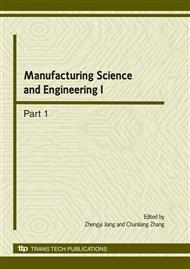p.1502
p.1506
p.1510
p.1514
p.1518
p.1527
p.1532
p.1542
p.1546
Microstructure and Reciprocating Sliding Tribological Performance of Micro-Arc Oxidation Coating Prepared on Al-Si Alloy
Abstract:
Micro-arc oxidation coatings were prepared on Al-Si alloys surface by using a self-made micro-arc oxidation equipment. Its characterizations were systematically detected by Vickers hardness tester, profilometer, scanning electron microscope (SEM), energy dispersive X-ray spectrum (EDX), X-ray diffractometer (XRD) and X-ray photoelectron spectroscopy (XPS). Reciprocating sliding tribological tests without lubricant of the micro-arc oxidation coating and its substrate alloy have been carried out under normal load of 5 N and displacement amplitudes of 2 mm. Dynamic analyses in combination with microscopic examinations were performed in detail through optical microscope (OM), SEM and EDX. The experimental results indicated that the MAO coating, with rough surface, high hardness and typical porous ceramic structure, is mainly consist of Al2O3, SiO2 and Al2SiO5 phases. The elementary substance Si and Al are not presented nearly on surface of coatings since the alloy is oxidated adequately during the micro arc oxidation process. Three stages can be observed in the friction coefficient curves both for the MAO coating and its substrate. The COF of the substrate was very low in initial stage, then a rapid ascend to a higher level and fluctuated in a larger range. But for the MAO coating, since its higher hardness and rough surface, the COF was higher than its substrate in initial stage. After a gradually ascent stage, the COF reached a steady state with a small range fluctuation and higher values. The wear mechanism for Al-Si alloy was main adhesive wear, abrasive wear, delamination and slight oxidative wear. After the micro-arc oxidation, the wear resistance of Al-Si alloy was greatly improved, and the wear mechanism of the MAO coating was the combination of delamination, abrasive wear, slight oxidative wear and some material transferred from the ball specimen.
Info:
Periodical:
Pages:
1518-1526
Citation:
Online since:
March 2010
Authors:
Price:
Сopyright:
© 2010 Trans Tech Publications Ltd. All Rights Reserved
Share:
Citation:


